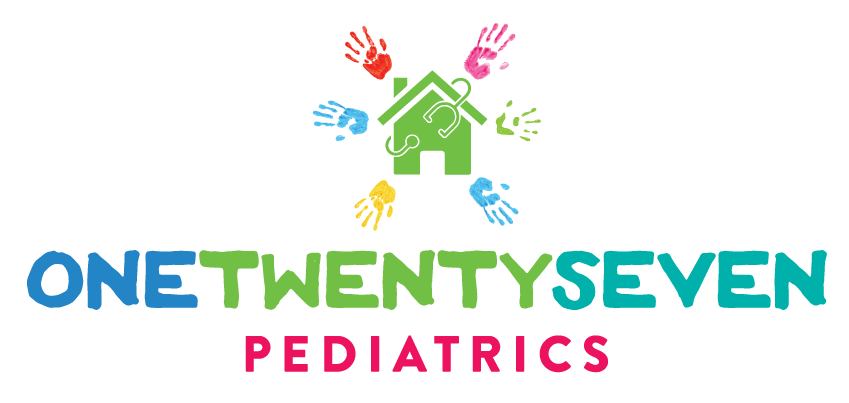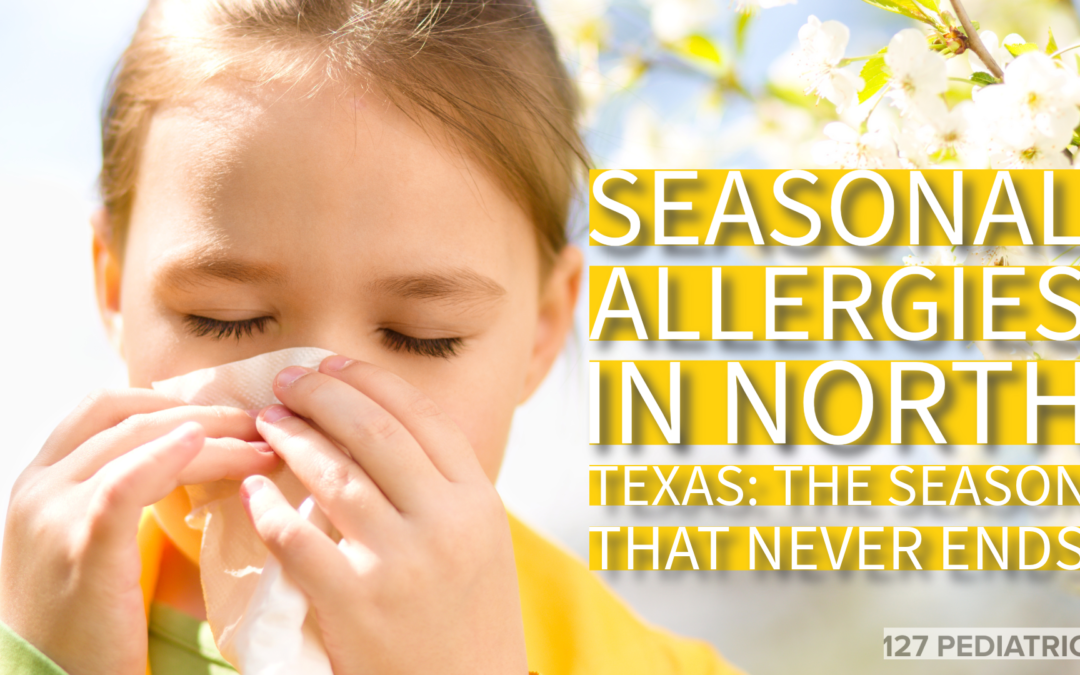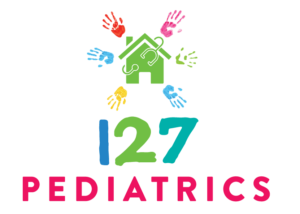As a house call pediatrician and North Texas native, I can tell you that allergy season in North Texas is the season that never ends. When a new family moves to the area, I tell them that everyone is allergic to Texas, it just may be a different season for each person.
In order to understand what I mean by that statement, we will look at the different allergens that are present in each season here in North Texas. Additionally, we talk about allergy symptoms and their treatment.
Seasonal allergies in North Texas is the season that never ends
Seasonal allergies, also known as hay fever or allergic rhinitis, are a common concern for children in North Texas. It is estimated that around 40% of children in this region suffer from seasonal allergies. These allergies are typically caused by sensitivity to airborne allergens such as pollen from grass, trees, and weeds.
Children with seasonal allergies often experience a range of unpleasant symptoms. These may include sneezing, a runny or stuffy nose, itchy and watery eyes, coughing, and a sore throat. These symptoms can significantly impact a child’s quality of life, affecting their ability to concentrate and participate in daily activities.
Parents in North Texas face several challenges when dealing with their children’s seasonal allergies. Firstly, it can be difficult to differentiate between typical cold symptoms and those caused by allergies. This can lead to delayed or inadequate treatment. Additionally, managing a child’s allergies can be time-consuming and financially burdensome. Parents often struggle to find effective ways to reduce their child’s exposure to allergens, especially during peak pollen seasons.
Various factors contribute to the high prevalence of seasonal allergies in North Texas. The region’s warm climate and abundant vegetation create an ideal environment for the proliferation of allergens. Additionally, North Texas experiences high levels of pollen due to its diverse plant life, such as oak, cedar, and ragweed.
What causes seasonal allergies
Seasonal allergies are triggered by the immune system’s response to allergens that are present in the environment during specific times of the year. The most common allergens that cause seasonal allergies are pollen from trees, grasses, and weeds. When these allergens enter the body through the nose, eyes, or mouth, the immune system identifies them as harmful substances and overreacts. As part of this reaction, the immune system releases chemicals such as histamine to defend the body.
This over-reaction results in the classic symptoms of seasonal allergies. The specific plants that trigger allergies can vary depending on the region and climate, with different plants releasing more pollen during specific seasons.
Symptoms of Children’s Seasonal Allergies
Children with seasonal allergies in North Texas may experience symptoms such as sneezing, congestion, itchy and watery eyes, coughing, swollen nasal passages and fatigue.
These symptoms overlap with symptoms of the common cold or an upper respiratory infection. So, how do you know if your child has a cold or allergy symptoms? Often, it can be difficult to tell. We definitely saw that during the COVID pandemic as we were trying to classify the cause for every sniffle. Almost always a distinguishing symptom between the two conditions is fever. Your child will not have a fever with seasonal allergies, but they often will with an upper respiratory infection.
Other symptoms include:
- Runny nose: A runny nose can be caused by allergies or the common cold, and it can be quite bothersome.
- Stuffy nose: When it comes to finding relief for a stuffy nose, there are several effective remedies that can provide comfort and help clear nasal congestion. These remedies include using a saline nasal spray, taking over-the-counter decongestants (only for older children), applying a warm compress to the face, staying hydrated, and inhaling steam. Additionally, allergy medicine helps as well.
- Sore throat: A sore throat is a common ailment that can cause discomfort and irritation. It is typically characterized by pain, scratchiness, and difficulty swallowing. Allergies are not the only potential cause for sore throat. There are several other causes such as viral infections, bacterial infections, and environmental irritants.
- Scratchy throat: A scratchy throat is a common occurrence that can cause discomfort and irritation. This symptom of seasonal allergies is especially troublesome as children often feel the need to “clear their throat” when they experience this symptom.
Common Triggers for Children’s Seasonal Allergies in North Texas
Children in North Texas can be particularly susceptible to seasonal allergies due to a variety of common triggers. Tree pollens are a major culprit, with oak, cedar, and pine trees being prevalent in the area. These pollens are known to cause allergic reactions such as sneezing, itchy eyes, and a runny nose.
Grass pollens are another common trigger in North Texas. Bermuda grass, Timothy grass, and Kentucky bluegrass are prevalent, especially during the spring and summer months. These grasses can release pollen that triggers allergies in children.
Ragweed is a significant allergen in the region. It typically emerges in late summer and early fall, releasing large amounts of pollen into the air. Ragweed pollen can travel for miles, leading to widespread allergic reactions in children.
Molds are another trigger that can exacerbate allergies in children. The warm and humid climate in North Texas provides an ideal environment for mold growth. Indoor molds may result from damp areas such as bathrooms or basements, while outdoor molds can thrive in decaying vegetation.
Additionally, other plants like sagebrush can also trigger allergies in children. These plants produce pollen that can induce allergic symptoms.
– Pollen from trees, grasses, and weeds
Pollen is a fine, powdery substance produced by plants, including trees, grasses, and weeds. It serves as a vital part of their reproductive process. However, for certain individuals, exposure to different types of pollen can cause varying degrees of allergic reactions.
Trees: The pollen from trees is released during spring when the flowering season occurs. Common tree pollen includes birch, oak, maple, cedar, and pine. These types of pollen can impact individuals by triggering allergic reactions such as itchy and watery eyes, sneezing, coughing, and nasal congestion. The distribution patterns of tree pollen depend on the specific tree species, geographic location, and prevailing weather conditions.
Grasses: Grass pollen is released during late spring and early summer. Common grasses that produce pollen include Bermuda grass, timothy grass, Kentucky bluegrass, and ryegrass. Exposure to grass pollen can cause symptoms such as runny nose, itchy throat, and asthma exacerbation in susceptible individuals. Grasses are widely distributed in various regions, including lawns, parks, and meadows.
Weeds: Weeds release pollen during late summer and fall. Common weed pollen includes ragweed, pigweed, lamb’s quarters, and giant ragweed. Exposure to weed pollen can lead to allergic reactions such as sneezing, itching, and sinus congestion. Weeds tend to grow in diverse habitats, including fields, roadsides, and gardens.
– Mold spores
Mold spores are tiny particles released by mold when it reproduces. While some mold spores are harmless, others can pose various health risks. One potential risk associated with mold spores is the development of allergies. Exposure to mold spores can trigger allergic reactions in sensitive individuals, leading to symptoms like sneezing, coughing, itchy eyes, and skin rashes.
In addition to allergies, mold spores can also cause respiratory issues. Inhalation of these spores can irritate the respiratory system and exacerbate existing respiratory conditions. Prolonged exposure to mold spores may lead to more severe respiratory problems, such as asthma attacks or fungal infections in the lungs.
To effectively identify and remove mold, one should start by inspecting the premises for visible signs. Mold often appears as discolored patches or a fuzzy texture on walls, ceilings, or other surfaces. However, it’s important to note that not all mold is easily visible, as it can grow in hidden areas like behind walls or under carpets.
In cases where the presence of mold is suspected but not visible, conducting air quality tests can help detect mold spores in the environment. These tests measure the levels of mold spores present in the air and can provide insights into the severity of the contamination.
If mold is confirmed, it is advisable to seek professional remediation services. Certified mold remediation specialists have the expertise and necessary equipment to safely remove mold, preventing further spread and minimizing health risks. They follow proper protocols to ensure thorough mold removal, addressing not only visible signs but also hidden sources of mold.
– Ragweed
Ragweed, scientifically known as Ambrosia, is a common weed that belongs to the Asteraceae family. It is characterized by its tall, erect stems that can reach up to five feet in height. The plant has deeply lobed leaves that are green in color, and its flowers are tiny and inconspicuous, arranged in dense clusters at the top of the stem.
Ragweed is notorious for its ability to produce large amounts of pollen, which can have detrimental effects on people. The pollen from ragweed is a potent allergen, leading to allergic reactions in a significant portion of the population. Symptoms include sneezing, runny nose, itchy and watery eyes, and in severe cases, difficulty breathing. These allergic reactions can significantly impact a person’s quality of life and productivity, particularly during the peak ragweed season.
Controlling ragweed can be challenging due to its high pollen production and rapid spread. However, several effective methods can help manage it. One approach is to physically remove the plant by uprooting it or cutting it at the base. It is crucial to use protective gloves when handling ragweed to avoid direct contact with the allergenic pollen. Regularly mowing grassy areas and keeping the surrounding environment clean can also help control the spread of ragweed.
Furthermore, applying herbicides specifically designed to target ragweed can be an effective control method. It is important to follow the instructions on the product label and apply the herbicide during the weed’s active growth period for optimal results. Additionally, preventing the growth and spread of ragweed by reducing its seed production is essential. This can be achieved by removing ragweed plants before they flower and produce seeds.
Central Texas cedar fever
Central Texas cedar fever is a common seasonal allergy that affects many individuals in the region. This condition is caused by an allergic reaction to pollen from the mountain cedar tree, which is abundant in Central Texas. Cedar fever is a colloquial term as this allergen does not cause true fever, but it makes susceptible people feel pretty miserable.
Symptoms of allergy to mountain cedar (juniper plant) can be quite severe. They range from sneezing and congestion to itchy eyes and a scratchy throat. While not a fever in the literal sense, the term “cedar fever” is used due to the fever-like symptoms that some individuals experience.
Even though the source of this pollen is from the juniper plant that resides in Central Texas, children in North Texas experience symptoms from this pollen due winds from the south that blow the pollen our direction. Mountain cedar season happens during the winter months in North Texas. This makes it especially problematic as it coincides with cold and flu season.
Diagnosis of Children’s Seasonal Allergies
In general, your child’s pediatrician can diagnose seasonal allergies by history and physical exam alone. If your child’s symptoms and exam are consistent with seasonal allergies, we often start with an over the counter anti-histamine medication. When I recommend this treatment, I often get push-back from parents. “I don’t want to give my child medication every day.”
Generally, I recommend that you give your child an anti-histamine medication daily for a short period of time. While allergens are present year round, most kids experience symptoms during a particular season.
If your child has particularly bad symptoms, I recommend consultation with an allergist. This specialized doctor will perform additional testing to identify the particular allergens that most affect your child.
Further testing can include skin-prick tests, where small amounts of allergens are applied to the skin to observe any reactions. Additionally, blood tests can measure the levels of allergy-specific antibodies.
Treatments of Childhood Allergy Sufferers
There are a variety of treatments available to families. Treatment of allergies often start with a trial of over the counter medications such as oral non-sedating antihistamines. Children with allergies may also benefit from steroid nasal sprays or anti-histamine eye drops. Most of these allergy medications are available for a reasonable cost at your local pharmacy or retail store. In general, the generic versions are just as effective as the name brand.
In addition to medications, saline nasal rinse or other forms of nasal irrigation are an important way to control symptoms. Rinsing the allergens from your child’s nose will go a long way to keep their itchy nose much happier. Also, I often recommend to families who have children with a particular plant pollen allergy to avoid outdoor activities as much as possible during high pollen counts. Additionally, I recommend that you bathe your children and wash their hair before bed each night especially on days where their pollen exposure is high.
If your children’s symptoms are particularly bad or these medications are not helping, allergy shots may be the answer. Allergy shots train your child’s immune system to not react to the allergen as vigorously. By giving increasing doses of the allergen over time, your child will eventually not react any more. Regular injections are pretty dramatic for younger children, so sometimes the allergist will recommend allergy drops first.
How Can 127 Pediatrics Help?
Dr. Wadley is passionate about educating parents about pediatric and breastfeeding topics. She believes that parents deserve to have evidence based information on which to base their children’s health care decisions. We would love for you to get on our email list so that you can receive a weekly dose of pediatric education straight to your inbox.
© 127 Pediatrics, March 2024


Dr. Andrea Wadley is a pediatrician and board certified breastfeeding medicine expert. She opened 127 Pediatrics in July 2018 as a way to provide a different option for parents in the DFW metroplex. Her pediatric practice is membership based. In addition, she offers breastfeeding consults to both members and non-members of her practice.


